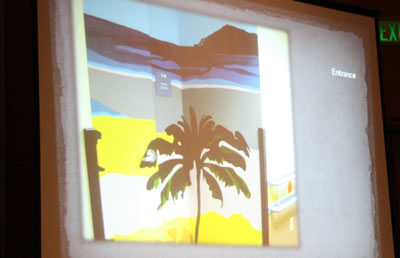 |  |  | |
News & Notices
News From:
Commissions
Conference & Stage Expo
For the Record
 | Opportunities in Interactive Design, a session at the 2009 Annual Conference in Cincinnati, was one of many presented by the Scene Design Commission that explored the theme of technology. Photo/Casey Kearns | |
| Technology Themes Recur at Scene Design Sessions Considering the shift from the now maturing Millennial Generation (M-Gens), toward the new crop of inherently wired Next-Gens, it was fitting that technology was the predominant topic during various Scene Design Commission sessions at the 2009 Annual Conference & Stage Expo. As a counterbalance, it was also encouraging and fitting to find interest in traditional, old-school technologies (i.e. painting and drawing specifically) – skill sets associated with the hand. Perhaps the notion of the pencil as a primary tool might seem initially out of sync in the moment; a false notion quickly dispelled by the sheer power and beauty of Paul Short’s exquisite sketches, renderings and presentation models. It calls to mind D.S. Goheen’s most notable quote: “If you can draw [with a pencil] you can design.” That was the bottom line. Despite the fact that Mr. Goheen is primarily a digital designer, his mantra is timely by underscoring a current defining generational quandary. As Millennials move into the market place and a YouTube Generation steps into the wings, the current discourse and inquiry over the relevance of digital vs. analogue as a competitive training methodology is both essential and critical within an academic community serving the profession. If ever there was a recurring topic or a circling of the wagons revolving around common themes, this was a most obvious equalizer. Hands on is essential – but a digital agenda has landed. The 2009 sessions provided a forum for diverse and recurring points-of-view. Curriculum Development/Teaching Vectorworks, a Professional Development Workshop on March 17, was an insightful, one-day workshop. Nemetschek’s Frank Brault introduced a “run before you can walk” concept arguing designers should start with digital first with a 3-D model as a point-of-entry. He presented methods for simulating traditional analog preliminaries with all electronic assets intact. He also addressed concerns over the limitations of viewing piece-meal minutia on a 20-inch screen saying the cost of a digital projector is approachable and affords a better view. One noteworthy session, Teaching the Millennial Generation, was timely and absolutely on target. As institutions more readily employ the use of blogs and social networking tools as a means to manage productions, efficiency is the endgame. By engaging new or relevant technologies, production teams are speaking a language more comfortable to this generation. Teaching Projections for the Theatre was an attempt to introduce the various facets of projection in an open discussion. It was one of the most engaging exchanges among panelist and attendees in Cincy. The session quickly evolved into an impromptu extended Q&A. 3-D Animation for Design Communication followed by Problem Solving through Digital Storyboarding were not only representative of the state of the art, but served as a clear indication that methodologies leading to greater efficiency may be the tools that define a generation. Nevertheless, Thursday’s discussion on Analogue vs. Digital was a serious philosophical discussion on how to build a balanced curriculum for the next generation. By placing a high value on empirical knowledge, light logic, and traditional motor-skills, panelists Dick Block, Frank Ludwig, and Michael Riha warned against losing sight of essential foundational training. | ||
United States Institute for Theatre Technology, Inc.: © 2009 Volume XLIX, Number 7